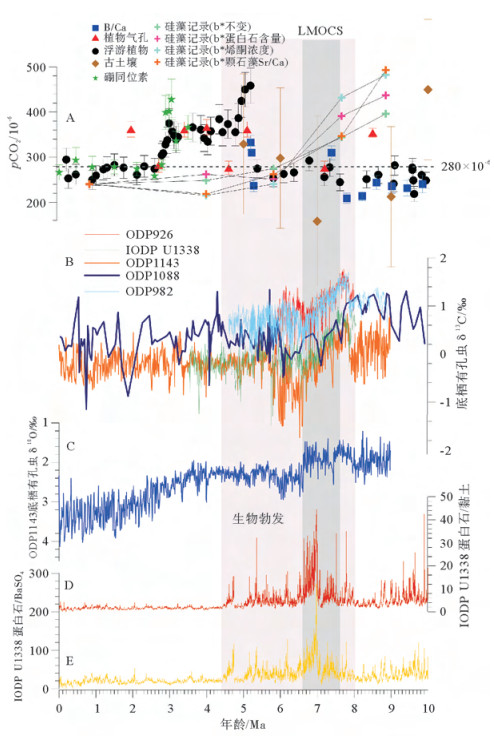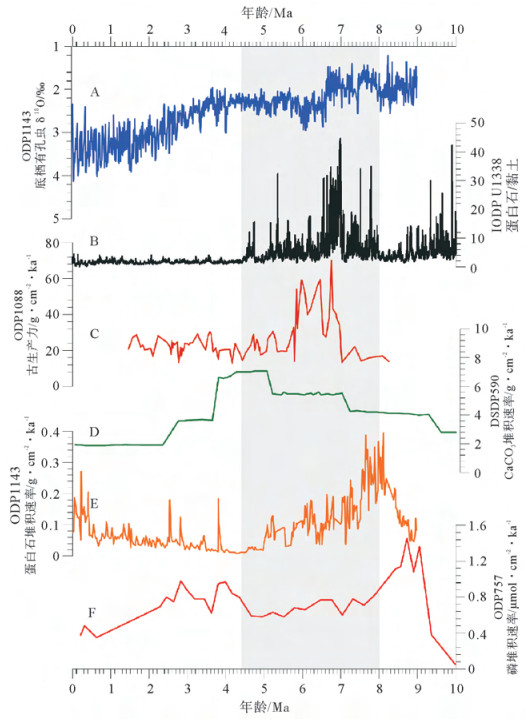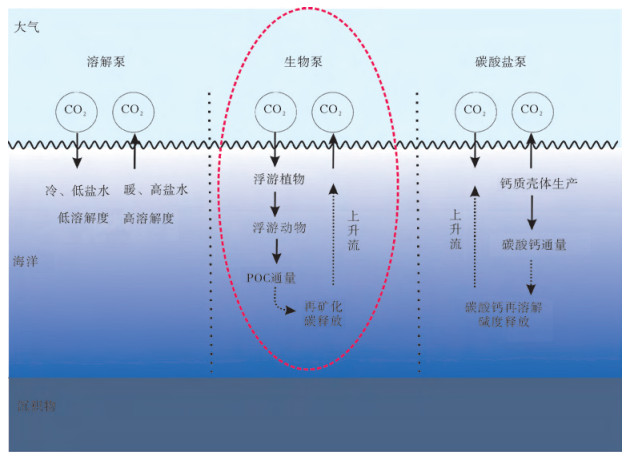Exploring the relationship between Late Miocene ocean carbon shift and productivity
-
摘要:
LMOCS (Late Miocene Ocean Carbon Shift)是距今最近的一次全球范围内表层水和底层水的碳同位素(δ13C)同步负偏事件。生物泵假说是解释LMOCS的经典理论之一。当生物勃发时, 生物泵可促进海水(δ13C)的分馏, 最终导致底栖有孔虫壳体的(δ13C)偏负。然而这一推论正被越来越多的证据所质疑。古生物和地球化学两大类替代性指标可重建过去生产力的变化、生物勃发以及生物泵的作用和效率。时间上, 大部分生物勃发事件比LMOCS开始更早而结束更晚。空间上, LMOCS已被证明具有全球性, 而生物勃发则不是。而且, 表层水和底层水的同向变化也和生物泵原理相悖。因此我们认为除生产力的变化之外, 还有其他导致LMOCS的原因。未来有待从全球水碳循环的集成研究、大气CO2的精确重建、计算机气候模拟等方面揭示LMOCS的驱动机制。
Abstract:The Late Miocene ocean carbon shift (LMOCS) is the most recent event characterized by synchronous decrease in both surface and deep water(δ13C) at a global scale, which is generally attributed to the biogenic pumping.When biogenic bloom event appears, the biogenic pump will start working to facilitate(δ13C) fractionation.As the results, benthic foraminiferal(δ13C) decreases.However, this inference is recently challenged by increasing facts and evidence.Generally, changes in paleo-productivity, biogenic bloom and the role and efficiency of biogenic pump can be reconstructed using paleontological and geochemical proxies.A compilation of these proxy records reveals the debates between the LMOCS and productivity.The onset and the cease of most biogenic bloom events led and lag the LMOCS, respectively.And the LMOCS is globally synchronous while the biogenic bloom event is not.Moreover, the synchronization of surface and deep water is also contrary to the principle of biologic pump.We thus propose that other reasons besides the changes in productivity should have accounted for the LMOCS.A further insight into the global hydrologic and carbon cycle, an improved reconstruction of atmospheric CO2level, and computer climate simulation studies will together help to unveil the driving mechanisms for the LMOCS.
-
Key words:
- δ13 C /
- LMOCS /
- biological pump /
- productivity /
- computer simulation
-

-
表 1 古生产力的代用指标及举例
Table 1. The proxies and examples of paleoproductivity
举例 参考文献 古
生
物
法生物标志物绝对含量/相对丰度 颗石藻的相对丰度 Molfino和McIntyre[35] 有机碳含量与生产力的经验公式 Müller和Suess[36] 生物沉积物 沉积物-水界面有机碳通量和沉积物表层 Brummer和Van Eijden[37] CaCO3含量之间的转换关系 堆积速率 底栖有孔虫堆积速率 Herguera和Berger[38] 属种组合法 底栖有孔虫内生种和外生种的比值 Jorissen等[39] 地
球
化
学
方
法沉积组分元素比值 生源Ba/黏土矿物Ti Murray等[40] 蛋白石/黏土; 蛋白石/BaSO4 Lyle和Baudalf[22] 痕量/微量元素 硫酸钡与有机碳通量的定量关系 Dymond等[41] 营养元素 大洋活性磷 Föllmi[42] 堆积速率 重晶石与生物Ba Averyt和Paytan[43] 同位素 表生与内生有孔虫碳同位素差值 Stott等[44] 快速沉积环境下的氮同位素 Higginson等[45] -
[1] Keigwin L D.Late Cenozoic stable isotope stratigraphy and paleoceanography of DSDP sites from the east equatorial and central North Pacific Ocean[J].Earth and Planetary Science Letters, 1979, 45 (2) :361-382. doi: 10.1016/0012-821X(79)90137-7
[2] Haq B U, Worsley T R, Burckle L H, et al.Late Miocene marine carbon-isotopic shift and synchroneity of some phytoplanktonic biostratigraphic events[J].Geology, 1980, 8 (9) :427-431. doi: 10.1130/0091-7613(1980)8<427:LMMCSA>2.0.CO;2
[3] Grant K M, Dickens G R.Coupled productivity and carbon isotope records in the southwest Pacific Ocean during the late Miocene-early Pliocene biogenic bloom[J].Palaeogeography Palaeoclimatology Palaeoecology, 2002, 187 (1) :61-82. http://www.wanfangdata.com.cn/details/detail.do?_type=perio&id=2e7c9d2dc7ef5617b3e5b770f7c3b7ea
[4] Dickens G R, Owen R M.The Latest Miocene-Early Pliocene biogenic bloom:a revised Indian Ocean perspective[J].Marine Geology, 1999, 161 (1) :75-91. doi: 10.1016/S0025-3227(99)00057-2
[5] Diester-Haass L, Billups K, Emeis K C.Late Miocene carbon isotope records and marine biological productivity:Was there a (dusty) link?[J].Paleoceanography, 2006, 21 (4) :247-257. http://cn.bing.com/academic/profile?id=9a5de05ce66511da94c3de05c68ca3fb&encoded=0&v=paper_preview&mkt=zh-cn
[6] Drury A J, John C M, Shevenell A E.Evaluating climatic response to external radiative forcing during the late Miocene to early Pliocene:New perspectives from eastern equatorial Pacific (IODP U1338) and North Atlantic (ODP 982) locations[J].Paleoceanography, 2016, 31 (1) :167-184. doi: 10.1002/2015PA002881
[7] Hodell D A, Curtis J H, Sierro F J, et al.Correlation of Late Miocene to Early Pliocene sequences between the Mediterranean and North Atlantic[J].Paleoceanography, 2001, 16 (2) :164-178. doi: 10.1029/1999PA000487
[8] Drury A J, Westerhold T, Frederichs T, et al.Late Miocene climate and time scale reconciliation:Accurate orbital calibration from a deep-sea perspective[J].Earth and Planetary Science Letters, 2017, 475:254-266. doi: 10.1016/j.epsl.2017.07.038
[9] Tian J, Ma X, Zhou J, et al.Subsidence of the northern South China Sea and formation of the Bashi Strait in the latest Miocene:Paleoceanographic evidences from 9-Myr high resolution benthic foraminiferalδ18 O andδ13C records[J].Palaeogeography, Palaeoclimatology, Palaeoecology, 2017, 466:382-391. doi: 10.1016/j.palaeo.2016.11.041
[10] Billups K.Late Miocene through early Pliocene deep water circulation and climate change viewed from the sub-Antarctic South Atlantic[J].Palaeogeography Palaeoclimatology Palaeoecology, 2002, 185 (3) :287-307. http://www.wanfangdata.com.cn/details/detail.do?_type=perio&id=05941b461e3676ba78eab7cc914cb8bd
[11] Beerling D J, Royer D L.Convergent Cenozoic CO2 history[J].Nature Geoscience, 2011, 4 (7) :418-420. doi: 10.1038/ngeo1186
[12] Lariviere J P, Ravelo A C, Crimmins A, et al.Late Miocene decoupling of oceanic warmth and atmospheric carbon dioxide forcing[J].Nature, 2012, 486 (7401) :97-100. doi: 10.1038/nature11200
[13] Herbert T D, Lawrence K T, Tzanova A, et al.Late Miocene global cooling and the rise of modern ecosystems[J].Nature Geoscience, 2016, 9 (11) :843-847. doi: 10.1038/ngeo2813
[14] Cerling T E, Harris J M, MacFadden B J, et al.Global vegetation change through the Miocene/Pliocene boundary[J].Nature, 1997, 389 (6647) :153-158. doi: 10.1038/38229
[15] Pagani M, Freeman K H, Arthur M A.Late Miocene atmospheric CO2 concentrations and the expansion of C4 grasses[J].Science, 1999, 285 (5429) :876-879. doi: 10.1126/science.285.5429.876
[16] Tripati A K, Roberts C D, Eagle R A.Coupling of CO2 and ice sheet stability over major climate transitions of the last 20 million years.[J].Science, 2009, 326 (5958) :1394-1397. doi: 10.1126/science.1178296
[17] Burgh J V D, Kürschner W M.Paleoatmospheric signatures in neogene fossil leaves.[J].Science, 1993, 260 (5115) :1788-1790. doi: 10.1126/science.260.5115.1788
[18] Seki O, Foster G L, Schmidt D N, et al.Alkenone and boron-based Pliocene pCO2 records[J].Earth & Planetary Science Letters, 2010, 292 (1) :201-211. http://www.wanfangdata.com.cn/details/detail.do?_type=perio&id=24143eefc8666cabe44d7e5563f23a9d
[19] Pagani M, Zachos J C, Freeman K H, et al.Marked decline in atmospheric carbon dioxide concentrations during the Paleogene.[J].Science, 2005, 309 (5734) :600-603. doi: 10.1126/science.1110063
[20] Ekart, Cerling, Montañez, et al.A 400million year carbon isotope record of pedogenic carbonate:Implications for paleoatmospheric carbon dioxide[J].American Journal of Science, 1999, 299 (10) :805-827. doi: 10.2475/ajs.299.10.805
[21] Mejía L M, Méndez-Vicente A, Abrevaya L, et al.A diatom record of CO2 decline since the late Miocene[J].Earth and Planetary Science Letters, 2017, 479:18-33. doi: 10.1016/j.epsl.2017.08.034
[22] Lyle M, Baldauf J.Biogenic sediment regimes in the Neogene equatorial Pacific, IODP Site U1338:Burial, production, and diatom community[J].Palaeogeography Palaeoclimatology Palaeoecology, 2015, 433 (4) :106-128.
[23] Hall R.Cenozoic geological and plate tectonic evolution of SEAsia and the SW Pacific:computer-based reconstructions, model and animations[J].Journal of Asian Earth Sciences, 2002, 20 (4) :353-431. doi: 10.1016/S1367-9120(01)00069-4
[24] Zhao Q, Li Q, Jian Z.Deep waters and oceanic connection[M]//The South China Sea.Netherlands, Springer, 2009: 395-437.
[25] Wang L W, Lin H L.Data report: carbonate and organic carbon contents of sediments from Sites 1143and 1146in the South China Sea[C]//Proceedings of the Ocean Drilling Program, Scientific Results.2004, 184: 1-9.
[26] Wang P, Prell W L, Blum P, et al.Proceedings of the Ocean Drilling Program[C]//Initial Results.2000: 184.
[27] Tian J, Yang M, Lyle M W, et al.Obliquity and long eccentricity pacing of the Middle Miocene climate transition[J].Geochemistry, Geophysics, Geosystems, 2013, 14 (6) :1740-1755. doi: 10.1002/ggge.20108
[28] Tian J, Ma W, Lyle M W, et al.Synchronous mid-Miocene upper and deep oceanicδ13 C changes in the east equatorial Pacific linked to ocean cooling and ice sheet expansion[J].Earth and Planetary Science Letters, 2014, 406:72-80. doi: 10.1016/j.epsl.2014.09.013
[29] Falkowski P, Scholes R J, Boyle E, et al.The global carbon cycle:A test of our knowledge of earth as a system[J].Science, 2000, 290 (5490) :291-296. doi: 10.1126/science.290.5490.291
[30] Hodell D A, Venz-Curtis K A.Late Neogene history of deepwater ventilation in the Southern Ocean[J].Geochemistry, Geophysics, Geosystems, 2006, 7 (9). http://d.old.wanfangdata.com.cn/NSTLQK/10.1029-2005GC001211/
[31] Butzin M, Lohmann G, Bickert T.Miocene ocean circulation inferred from marine carbon cycle modeling combined with benthic isotope records[J].Paleoceanography, 2011, 26 (1). http://www.wanfangdata.com.cn/details/detail.do?_type=perio&id=10.1029/2009PA001901
[32] Falkowski P G, Laws E A, Barber R T, et al.Phytoplankton and Their Role in Primary, New, and Export Production[M]//Ocean Biogeochemistry.Springer Berlin Heidelberg, 2003: 99-121.
[33] Eppley R W, Peterson B J.Particulate organic matter flux and planktonic new production in the deep ocean[J].Nature, 1979, 282 (5740) :677-680. doi: 10.1038/282677a0
[34] Berger W, Smetacek V, Wefer G.Ocean productivity and paleoproductivity-An overview[R]//Productivity of the Oceans Present and Past: Report of the Dahlem Workshop on Productivity of the Ocean.Berlin: Life Sciences Research Reports 44, Wiley & Sons, Chichester, 1989: 1-34.
[35] Molfino B, McIntyre A.Precessional forcing of nutricline dynamics in the Equatorial Atlantic[J].Science, 1990, 249 (4970) :766-769. doi: 10.1126/science.249.4970.766
[36] Müller P J, Suess E.Productivity, sedimentation rate, and sedimentary organic matter in the oceans-I.Organic carbon preservation[J].Deep Sea Research Part A.Oceanographic Research Papers, 1979, 26 (12) :1347-1362. doi: 10.1016/0198-0149(79)90003-7
[37] Brummer G J A, Van Eijden A J M."Blue-ocean"paleoproductivity estimates from pelagic carbonate mass accumulation rates[J].Marine Micropaleontology, 1992, 19 (1-2) :99-117. doi: 10.1016/0377-8398(92)90023-D
[38] Herguera J C, Berger W H.Paleoproductivity from benthic foraminifera abundance:Glacial to postglacial change in the west-equatorial Pacific[J].Geology, 1991, 19 (19) :1173-1176.
[39] Jorissen F J, Fontanier C, Thomas E.Chapter Seven Paleoceanographical Proxies Based on Deep-Sea Benthic Foraminiferal Assemblage Characteristics[M]//Developments in Marine Geology.Elsevier Science & Technology, 2007: 263-325.
[40] Murray R W, Knowlton C, Leinen M, et al.Export production and terrigenous matter in the Central Equatorial Pacific Ocean during interglacial oxygen isotope Stage 11[J].Global and Planetary Change, 2000, 24 (1) :59-78. doi: 10.1016/S0921-8181(99)00066-1
[41] Dymond J, Suess E, Lyle M.Barium in deep-sea sediment:A geochemical proxy for paleoproductivity[J].Paleoceanography, 1992, 7 (2) :163-181. doi: 10.1029/92PA00181
[42] Föllmi K B.The phosphorus cycle, phosphogenesis and marine phosphate-rich deposits[J].Earth-Science Reviews, 1996, 40 (1-2) :55-124. doi: 10.1016/0012-8252(95)00049-6
[43] Averyt K B, Paytan A.A comparison of multiple proxies for export production in the equatorial Pacific[J].Paleoceanography, 2004, 19 (4) :117-196. http://d.old.wanfangdata.com.cn/NSTLQK/10.1029-2004PA001005/
[44] Stott L D, Berelson W, Douglas R, et al.Increased dissolved oxygen in Pacific intermediate waters due to lower rates of carbon oxidation in sediments[J].Nature, 2000, 407 (6802) :367-370. doi: 10.1038/35030084
[45] Higginson M J, Maxwell J R, Altabet M A.Nitrogen isotope and chlorin paleoproductivity records from the Northern South China Sea:remote vs.local forcing of millennial-and orbital-scale variability[J].Marine Geology, 2003, 201 (1) :223-250. http://cn.bing.com/academic/profile?id=dc0501db3e7e30ffb5fa0ceb22fdbe9b&encoded=0&v=paper_preview&mkt=zh-cn
[46] Lopes C, Kucera M, Mix A C.Climate change decouples oceanic primary and export productivity and organic carbon burial[J].Proceedings of the National Academy of Sciences, 2015, 112 (2) :332-335. doi: 10.1073/pnas.1410480111
[47] Ren J, Gersonde R, Esper O, et al.Diatom distributions in northern North Pacific surface sediments and their relationship to modern environmental variables[J].Palaeogeography Palaeoclimatology Palaeoecology, 2014, 402 (4) :81-103. doi: 10.1016/j.palaeo.2009.12.006
[48] Calvert S E, Pedersen T F.Chapter fourteen elemental proxies for palaeoclimatic and palaeoceanographic variability in marine sediments:interpretation and application[J].Developments in Marine Geology, 2007, 1:567-644. doi: 10.1016/S1572-5480(07)01019-6
[49] Delaney M L, Boyle E A.Cd/Ca in late Miocene benthic foraminifera and changes in the global organic carbon budget[J].Nature, 1987, 330 (6144) :156-159. doi: 10.1038/330156a0
[50] Matthews K A, Grottoli A G, McDonough W F, et al.Upwelling, species, and depth effects on coral skeletal cadmium-to-calcium ratios (Cd/Ca) [J].Geochimica et Cosmochimica Acta, 2008, 72 (18) :4537-4550. doi: 10.1016/j.gca.2008.05.064
[51] Schenau S J, Reichart G J, Lange G J D.Phosphorus burial as a function of paleoproductivity and redox conditions in A-rabian Sea sediments[J].Geochimica et Cosmochimica Acta, 2005, 69 (4) :919-931. doi: 10.1016/j.gca.2004.05.044
[52] Leinen M.Biogenic Silica Accumulation in the Central Equatorial Pacific and its Implications for Cenozoic Paleoceanography[J].Social Science Electronic Publishing, 1979, 90 (9) :1-46. http://cn.bing.com/academic/profile?id=f9987287975ae40e2daddace849f049e&encoded=0&v=paper_preview&mkt=zh-cn
[53] Theyer F, Mayer L A, Barron J A, et al.The equatorial Pacific high-productivity belt:Elements for a synthesis of Deep Sea Drilling Project Leg 85results[J].Initial Reports of the Dep Sea Drilling Project, 1985. http://cn.bing.com/academic/profile?id=4d47aea72db86acdef3d691915f22319&encoded=0&v=paper_preview&mkt=zh-cn
[54] Farrell J, Raffi I, Janecek T, et al.Late Neogene sedimentation patterns in the Eastern Equatorial Pacific Ocean[J].Proceedings of the Ocean Drilling Program Scientific Results, 1995, 138:717-756. http://www.wanfangdata.com.cn/details/detail.do?_type=perio&id=J-STAGE_3230160
[55] Berger W H, Leckie R M, Janecek T R, et al.44.Neogene carbonate sedimentation on Ontong Java Plateau:Highlights and open questions[J].Proceedings of the Ocean Drilling Program Scientific Results, 1993, 130:711-744.
[56] Diester-Haass L, Billups K, Emeis K C.In search of the late Miocene-early Pliocene"biogenic bloom"in the Atlantic O-cean (Ocean Drilling Program Sites 982, 925, and 1088) [J].Paleoceanography, 2005, 20 (4). doi: 10.1029/2005PA001139
[57] Hermoyian C S, Owen R M.Late Miocene-early Pliocene biogenic bloom:Evidence from low-productivity regions of the Indian and Atlantic Oceans[J].Paleoceanography, 2001, 16 (1) :95-100. doi: 10.1029/2000PA000501
[58] Cortese G, Gersonde R, Hillenbrand C D, et al.Opal sedimentation shifts in the world ocean over the last 15 Myr[J].Earth & Planetary Science Letters, 2004, 224 (3-4) :509-527. http://www.wanfangdata.com.cn/details/detail.do?_type=perio&id=e784c771890e8c15ca074d4fa99bd2ef
[59] Filippelli G M.The global phosphorus cycle:past, present, and future[J].Elements, 2008, 4 (2) :89-95. doi: 10.2113/GSELEMENTS.4.2.89
[60] Zhang Y G, Pagani M, Henderiks J, et al.A long history of equatorial deep-water upwelling in the Pacific Ocean[J].Earth & Planetary Science Letters, 2017, 467:1-9. http://www.wanfangdata.com.cn/details/detail.do?_type=perio&id=b368a069429f042830cfb444cf7c2e2e
[61] Ravelo A C, Lawrence K T, Fedorov A, et al.Comment on"A 12-million-year temperature history of the tropical Pacific Ocean"[J].Science, 2014, 346 (6216) :1467-1467. doi: 10.1126/science.1257930
[62] Filippelli G M.Intensification of the Asian monsoon and a chemical weathering event in the late Miocene-early Pliocene:implications for late Neogene climate change[J].Geology, 1997, 25 (1) :27-30.
[63] Murray R W, Leinen M, Knowlton C W.Links between iron input and opal deposition in the Pleistocene equatorial Pacific Ocean[J].Nature Geoscience, 2012, 5 (4) :270-274. http://www.wanfangdata.com.cn/details/detail.do?_type=perio&id=cc615aedbfe036f1236c3f9521be9ea6
[64] Diester-Haass L, Meyers P A, Bickert T.Carbonate crash and biogenic bloom in the late Miocene:Evidence from ODPSites 1085, 1086, and 1087in the Cape Basin, southeast Atlantic Ocean[J].Paleoceanography, 2004, 19.
[65] Haug G H, Tiedemann R.Effect of the formation of the Isthmus of Panama on Atlantic Ocean thermohaline circulation[J].Nature, 1998, 393 (3) :673-676. doi: 10.1038/31447
[66] Nathan S A, Leckie R M.Early history of the Western Pacific Warm Pool during the middle to late Miocene (13.2~5.8Ma) :Role of sea-level change and implications for equatorial circulation[J].Palaeogeography Palaeoclimatology Palaeoecology, 2009, 274 (3) :140-159.
[67] Li J, Wang R, Li B.Variations of opal accumulation rates and paleoproductivity over the past 12Ma at ODP Site 1143, southern South China Sea[J].Chinese Science Bulletin, 2002, 47 (7) :596-598. doi: 10.1360/02tb9137
[68] 孙军, 李晓倩, 陈建芳, 等.海洋生物泵研究进展[J].海洋学报, 2016, 38 (4) :1-21. doi: 10.3969/j.issn.0253-4193.2016.04.001
SUN Jun, LI Xiaoqian, CHEN Jianfang, et al.Progress in oceanic biological pump[J].Acta Oceanologica Sinica, 2016, 38 (4) :1-21. doi: 10.3969/j.issn.0253-4193.2016.04.001
[69] Heinze C, Maier-Reimer E, Winn K.Glacial pCO2 reduction by the world ocean: Experiments with the Hamburg Carbon Cycle Model[J].Paleoceanography, 1991, 6 (4) :395-430. doi: 10.1029/91PA00489
[70] Rocha C L D L, Passow U.Factors influencing the sinking of POC and the efficiency of the biological carbon pump[J].Deep Sea Research Part Ⅱ Topical Studies in Oceanography, 2007, 54 (5-7) :639-658. doi: 10.1016/j.dsr2.2007.01.004
[71] Martin J H, Knauer G A, Karl D M, et al.VERTEX:carbon cycling in the northeast Pacific[J].Deep-Sea Research, 1987, 43:267-285. http://d.old.wanfangdata.com.cn/Periodical/dllgdxxb201704015
[72] 李铁刚, 赵京涛, 孙荣涛, 等.250kaBP以来西太平洋暖池中心区——Ontong Java海台古生产力演化[J].第四纪研究, 2008, 28 (3) :447-457. doi: 10.3321/j.issn:1001-7410.2008.03.009
LI Tiegang, ZHAO Jingtao, SUN Rongtao, et al.Paleoproductivity evolution in the ontong java plateau-center of the western pacific warm pool during the last 250ka[J].Quaternary Sciences, 2008, 28 (3) :447-457. doi: 10.3321/j.issn:1001-7410.2008.03.009
[73] Vincent E, Killingley J S, Berger W H.The Magnetic Epoch-6carbon shift:A change in the ocean′s 13C/12C ratio 6.2million years ago[J].Marine Micropaleontology, 1980, 5:185-203.
[74] Elmstrom K M, Kennett J P.Late neogene paleoceanographic evolution of site 590-southwest pacific[J].Initial Reports of the Deep Sea Drilling Project, 1986, 90:1361-1381. http://cn.bing.com/academic/profile?id=bfb16755600a04242414c58640ecd4b5&encoded=0&v=paper_preview&mkt=zh-cn
[75] Wang P X, Li Q Y, Tian J, et al.Long-term cycles in the carbon reservoir of the Quaternary ocean:aperspective from the South China Sea[J].National Science Review, 2014, 1 (1) :119-143. doi: 10.1093/nsr/nwt028
[76] Jiao N, Herndl G J, Hansell D A, et al.Microbial production of recalcitrant dissolved organic matter:long-term carbon storage in the global ocean[J].Nature Reviews Microbiology, 2010, 8 (8) :593-599. doi: 10.1038/nrmicro2386
[77] Bickert T, Haug G H, Tiedemann R.Late Neogene benthic stable isotope record of Ocean Drilling Program Site 999:Implications for Caribbean paleoceanography, organic carbon burial, and the Messinian Salinity Crisis[J].Paleoceanography, 2004, 19 (1), doi:10.1029/2002PA000799.
[78] Kump L R, Arthur M A.Interpreting carbon-isotope excursions:carbonates and organic matter[J].Chemical Geology, 1999, 161 (1-3) :181-198. doi: 10.1016/S0009-2541(99)00086-8
[79] Herman F, Seward D, Valla P G, et al.Worldwide acceleration of mountain erosion under a cooling climate[J].Nature, 2013, 504 (7480) :423-426. doi: 10.1038/nature12877
[80] Willenbring J K, von Blanckenburg F.Long-term stability of global erosion rates and weathering during late-Cenozoic cooling[J].Nature, 2010, 465 (7295) :211-214. doi: 10.1038/nature09044
[81] Vincent E, Berger W H.Carbon dioxide and polar cooling in the Miocene: The Monterey hypothesis[C].AGU, Washington D C, Geophys.Monogr., 1985, 32: 455-468.
[82] 张江勇, 汪品先.深海研究中的底栖有孔虫:回顾与展望[J].地球科学进展, 2004, 19 (4) :545-551. doi: 10.3321/j.issn:1001-8166.2004.04.009
ZHANG Jiangyong, WANG Pinxian.Benthic foraminifera in deep-sea research:Retrospect and prospect[J].Advances in Earth Science, 2004, 19 (4) :545-551. doi: 10.3321/j.issn:1001-8166.2004.04.009
[83] Wang P, Zhao Q, Jian Z, et al.Thirty million year deep sea records in the South China Sea[J].Chinese Science Bulletin, 2003, 48 (23) :2524-2535. doi: 10.1007/BF03037016
[84] Miller K G, Wright J D, Fairbanks R G.Unlocking the Ice House:Oligocene-Miocene oxygen isotopes, eustasy, and margin erosion[J].Journal of Geophysical Research Solid Earth, 1991, 96 (B4) :6829-6848. doi: 10.1029/90JB02015
[85] Shevenell A E, Kennett J P, Lea D W.Middle Miocene Southern Ocean cooling and Antarctic cryosphere expansion.[J].Science, 2004, 305 (5691) :1766-1770. doi: 10.1126/science.1100061
[86] Sigman D M, Boyle E A.Glacial/interglacial variations in atmospheric carbon dioxide[J].Nature, 2000, 407 (6806) :859-869. doi: 10.1038/35038000
[87] Keller K M, Joos F, Lehner F, et al.Detecting changes in marine responses to ENSO from 850to 2100C.E.:Insights from the ocean carbon cycle[J].Geophysical Research Letters, 2015, 42 (2) :518-525. doi: 10.1002/2014GL062398
[88] 丁仲礼, 熊尚发.古气候数值模拟:进展评述[J].地学前缘, 2006, 13 (1) :21-31. doi: 10.3321/j.issn:1005-2321.2006.01.004
DING Zhongli, XIONG Shangfa.Numerical modeling in paleoclimate study:Progress and problems[J].Earth Science Frontiers, 2006, 13 (1) :21-31. doi: 10.3321/j.issn:1005-2321.2006.01.004
[89] Ruddiman W F, Kutzbach J E.Forcing of late Cenozoic northern hemisphere climate by plateau uplift in southern A-sia and the American West[J].Journal of Geophysical Research:Atmospheres, 1989, 94 (D15) :18409-18427. doi: 10.1029/JD094iD15p18409
[90] Maier-Reimer E, Mikolajewicz U, Crowley T.Ocean general circulation model sensitivity experiment with an open Central American Isthmus[J].Paleoceanography, 1990, 5 (3) :349-366. doi: 10.1029/PA005i003p00349
[91] Shellito C J, Sloan L C, Huber M.Climate model sensitivity to atmospheric CO 2, levels in the Early-Middle Paleogene[J].Palaeogeography Palaeoclimatology Palaeoecology, 2003, 193 (1) :113-123. doi: 10.1016/S0031-0182(02)00718-6
[92] Liu Z, Otto-Bliesner B L, He F, et al.Transient simulation of last deglaciation with a new mechanism for Bølling-Allerød warming[J].Science, 2009, 325 (5938) :310-314. doi: 10.1126/science.1171041
[93] O'Dea A, Lessios H A, Coates A G, et al.Formation of the Isthmus of Panama[J].Science Advances, 2016, 2 (8), doi:1126/sciadv.1600883.
[94] Kamikuri S I, Motoyama I, Nishi H, et al.Evolution of Eastern Pacific Warm Pool and upwelling processes since the middle Miocene based on analysis of radiolarian assemblages:Response to Indonesian and Central American Seaways[J].Palaeogeography Palaeoclimatology Palaeoecology, 2009, 280 (4) :469-479. doi: 10.1016/j.palaeo.2009.06.034
[95] Schourupkristensen V, Sidorenko D, Wolfgladrow D A, et al.A skill assessment of the biogeochemical model REcoM2 coupled to the Finite Element Sea Ice-Ocean Model (FESOM1.3) [J].Geoscientific Model Development, 2014, 7 (4) :2769-2802. doi: 10.5194/gmd-7-2769-2014
[96] Ilyina T, Six K D, Segschneider J, et al.Global ocean biogeochemistry model HAMOCC: Model architecture and performance as component of the MPI-Earth system model in different CMIP5 experimental realizations[J].Journal of Advances in Modeling Earth Systems, 2013, 5 (2) :287-315. doi: 10.1029/2012MS000178
-




 下载:
下载:

